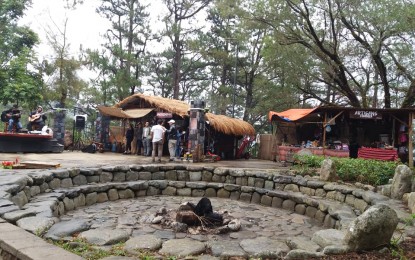
The traditional ‘Dap-ay’ where the Cordillera men in the olden times sit to discuss issues and solve problems of the community. It stands on the center of the ‘Ili-ay Cordillera’- a depiction of how the Cordillerans live. (Photo by Liza T. Agoot/PNA)
BAGUIO CITY--Camp John Hay has opened its door to the rich cultural heritage of the Cordilleras, giving way for the "Ili-ay Cordillera” in this mountain resort city to allow even the tourists to see, experience, and appreciate Igorot life.
“Ili-ay Cordillera”, means depicting a village or town in the Cordillera, and observing the practices and the tradition of the people in the region.
"It is a celebration of Igorot art and culture. It was initiated by the Manor (hotel) as a way to connect with and give back to the wider community that it belongs to which literally serves as a window to the rich cultural heritage of the Cordilleras," said Karlo Marko Altomonte, Ili-ay Cordillera organizer in an interview on Thursday.
The Manor Hotel allotted a space near the former “Honeymoon” cottage, an area that is lined by pine trees, where the traditional “dap-ay” was built years ago.
A dap-ay is a circle-shaped outdoor place built using rocks with a bonfire area at the center. It was used by the old male folks to discuss issues involving the community.
Altomonte said the village serves as a venue for traditional and modern indigenous arts and crafts exhibitions, performances, workshops and fora.
"We are not just providing a peek into the culture of Cordillera but we advocate the spirit of the community life. It gives the tourists a feel of what village life is, where everybody works together," he said.
In 2017, the United Nations Educational, Scientific and Cultural Organization (UNESCO) added Baguio to the list of 64 cities from 44 countries in the “Creative Cities” network, with the aim of making creative innovations as key drivers for a more sustainable and inclusive urban development.
Altomonte said the establishment of the Cordillera village is part of the efforts to retain the city’s honor for its distinguished crafts and arts.
He said the highlights of the village includes a traditional Ifugao hut, a smokehouse that offers Igorot cuisine and delicacies, a carvers' workshop that showcases loom and handwoven crafts, a weavers’ corner with the region's finest woven textiles, an organic farmer's market and an artisan's shed that features Cordillera-inspired works.
"I think what is common among the Cordillera people is that they live their life in harmony with their natural surroundings. That is basically what I have learned from the indigenous people's community," he said.
Cordillera village
Altomonte said the construction of the seemingly simple Ifugao hut is a feat of indigenous architectural, engineering and woodcarving skills.
He said it was traditionally built without using nails where each segment of the hut is meticulously designed and measured to fit with the other segments, perfectly much like a jigsaw puzzle.
The village brings the Cordillera food experience closer to everyone with Chavi Romawac of My Chef Romawac and Pil-od of “Farmers Daughter” at the helm in the kitchen, the "ili"s smokehouse offers indigenous cuisines like “etag” or smoked meat, native dish “pinikpikan” and “pinuneg” (blood sausage).
He said all of the ingredients that the smokehouse chefs use come from the farmers' market-- a system in an ordinary “ili” in the Cordillera where a lacking ingredient can be sourced from the neighbor’s yard.
"While modern farming methods have been adopted by Benguet farmers, in recent years, many have been reverting to traditional practices to produce pesticide-free, organically-grown vegetables," he said.
He said one of the stalls in the village which is the Carvers' shed represents the city's creative city tag.
"More commonly known of their magnificent rice terraces which has been declared by UNESCO as a cultural heritage site, the Ifugao people are also famed for their woodcarving skills." he said.
The intricate patterns and colors of Igorot textile go beyond aesthetics: every design tells a story and each of the several ethno-linguistic groups has its own story to tell in the Weaver's hut.
Altomonte said there is also a designated corner for artists and artisans.
"From hand painted shirts to jewelry, this corner brings together both traditional and modern craftsmen and artisans offering a variety of creative products and services," he said.
The Dap-ay also serves as place for a young “mambabatok” (traditional tattoo artist) from Ina Whang-od’s village, Barangay Buscalan in Tinglayan, Kalinga.
The village was launched last March 1. It will last until the end of May.
During weekends, the village is filled with exciting events such as music, dance and theatrical performances, workshops demonstrations, artist talks, film showings, among others. (PNA)
